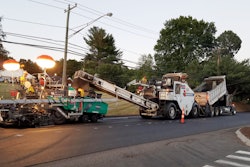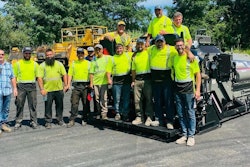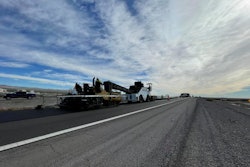This week we're joined by Brandon Strand, executive director of the Wisconsin Asphalt Pavement Association. Brandon will talk to us about the importance of joining your state's asphalt association and the benefits they provide. Plus, the Infrastructure Investment & Jobs Act is headed to President Biden's desk for a signature. Jess & Dormie will go over some of the key details of what's in the bill.
J: Tell me a little bit about yourself, how you got started in the industry and what you do in your current role at the Wisconsin Asphalt Pavement Association?
D: What is the role of a state asphalt pavement association in the industry and why should mix producers and paving contractors join?J: Expanding on the last questions, what are some additional benefits companies can receive from joining their SAPA?
:::WE DRINK::
D: The WAPA annual meeting is coming up on December 1st, tell us a little bit about the meeting, what topics will be covered and why companies should take time out of their schedules to attend?
J: Being a part of your SAPA means you also get industry insight from the national asphalt pavement association. Tell us a little bit about the benefits of that for asphalt companies?
D: We are very much looking forward to the event next month and for contractors out there watching, Brandon tell us a little bit about how they can get involved with their SAPA and attend the meetings.
J: Final question we always ask…What is your favorite thing about the industry?
::WE DRINK:::
J: Well everyone, it finally happened. After weeks of party infighting and debate, House Democrats late Friday night clinched a long-sought victory on President Biden’s domestic agenda, passage of the $1.2 trillion bipartisan infrastructure bill named the Infrastructure Investment & Jobs Act (IIJA).
D: The passage came after a progressive Democrats agreed to compromise with the rest of the party to unlink Biden's larger economic package, the Build Back Better plan, from the Senate-passed bipartisan infrastructure deal. The climate and social spending package is now being negotiated with final language being drafted. It will then receive a cost estimate from the nonpartisan Congressional Budget Office (CBO). It is expected to reach the floor the week of Nov. 15.
J: Now that this legislation is set to become law when Biden signs it on Monday during a special bipartisan ceremony, communities across the country will begin to reap the benefits of these investments in the weeks and months ahead. Let’s drink to that!
:::WE DRINK:::
D:This infrastructure bill contains $550 billion in new federal spending, which will largely be invested over five years. The bill contains funding to improve roads, bridges and passenger rail, update ports of entry, expand broadband access, build a network of electric vehicle charging stations and remove lead pipes, among other provisions and we’re going to dive into some of those that impact our industry the most.
J: IIJA increases our national investment in safe roads and bridges by 55% over the FAST Act’s 2015 baseline. As a result, the national asphalt pavement association projects that each state will receive more than $1 billion total in Federal Highway Administration funding to repair and improve roads and bridges. The Infrastructure Investment and Jobs Act importantly includes the Surface Transportation Reauthorization Act of 2021, legislation reported by the Senate Committee on Environment and Public Works (EPW) in May. This legislation would invest record amounts of funding in our nation’s highway programs to improve and repair our highways and bridges.
D: On top of those reauthorization levels, $110 billion, the biggest-ticket item in the bill, will be used for building and repairing roads and bridges across the country. IIJA will invest a total of $40 billion in bridge funding. In addition, the bill provides $27.5 billion ($5.5 billion annually) in general funds for a new bridge replacement formula program. The bill establishes a new formula to distribute the funds with each state guaranteed to receive a minimum of $45 million annually.
J: The bill includes $25 billion for airports. Of that amount, $15 billion is distributed by formula over five years for grants to airports to use for their Airport Improvement Program (AIP). Grants can be used for runways, taxiways, and aprons. About $5 billion would go specifically toward upgrading air traffic control towers and systems.
D: The U.S. passenger rail system, a favorite of Biden’s, receives a large chunk of funding to the tune of $66 billion, for upgrades and maintenance.
J: It’s important to note that there is only that $550 in NEW spending in this package, only - right? Lawmakers often like to refer to the bill as a $1.2 trillion package because they are also counting that funding that is normally allotted each year for highways and other projects. Still this money is sorely needed to help repair our infrastructure and we will drink to that!
:::WE DRINK:::
D: Lawmakers and the White House are touting the huge number of jobs this bill would help generate. Many construction jobs do not require college degrees, though they do require some special skills. Mark Zandi, chief economist at Moody’s Analytics, estimates growth of about 660,000 jobs could result by 2025.
J: We know what you’re thinking. We don’t have the people to do the work we have today, let alone support new projects and this new job creation. We understand and we hear it every day. Experts agree that the IIJA should have had a much larger human capital development component in it, but since it doesn’t we need to work hard and find ways to attract people to the industry.
D: Labor shortages, workforce systems not aligned with industry demand, insufficient access to career pathways and significant retirements of skilled and semi-skilled workers are affecting infrastructure jobs immensely. Unfortunately, these trends have also collided with disinvestment in workforce training overall, and specifically in career and technical education, as well as less education to youth about the benefits of a career in skilled trades and manufacturing.
J: New investments in workforce development are critical to ensuring the long-term success of the IIJA. Local leaders are already driving practical, local solutions to address workforce needs, partnering with community colleges, career and technical high schools and other programs to expand access to training and skills development. But they need a strong federal partner to help us invest at-scale in the training and education programs necessary to connect more local residents to high-quality jobs.
D: This also represents an opportunity to induce more Americans into apprenticeship and similarly situated programs. We are going to need to create an extraordinarily talented pool of construction workers who can continue to help build out America in various ways even after these infrastructure dollars have been spent.
J: More needs to be done. Not investing in our infrastructure workforce will result in increased costs and delays for infrastructure projects, potentially jeopardizing the quality of the work done, and significant missed opportunities to strengthen communities. We have thousands of ways to attract and retain workers on our website, but it’s going to take all of us touting the benefits of these careers to attract a large enough workforce we we’re going to keep sharing some tricks with you here.
D: We will start with what seems like a no brainer, spread the word to local students in your communities. Work with your local high schools to rent a table at a job fair, give a presentation or host a day on the jobsite, shop or guided tour, so students can get a sense of what the paving and roadbuilding industry is all about. Your company could also offer summer jobs or internship opportunities. When these students graduate from high school, you will be the first company they will turn to because they will remember that day on the job or the summer they worked with you.
J: Remember that you are competing with other companies for workers, and there are many opportunities out there for work right now. Be certain your compensation offerings are where they need to be. Offering a competitive wage can help potential applicants and current employees feel like their work and time is valued. Bonus programs, signing bonuses, pension, health plans and paid time off can send a powerful message to potential employees about how you treat your staff in your company.
D: This kinda goes along with my first point about spreading the word to students. Your company needs to be crafty at attracting young talent. They can be a tough nut to crack when it comes to opening their eyes and minds to the wide-range of opportunities. This generation wants to feel like they work for a company that is working hard to be an industry leader. What I mean is try to implement technology, processes or new equipment that can help employees do their jobs more comfortably and efficiently. Or if you’re doing something worth talking about, go to social media and share the exciting news to your audience, because this generation resorts to social media to investigate companies.
J: As you all know, something near and dear to me is safety, and what better way to recruit employees than highlighting your company safety standards. Talk about your long-term safety record and your company’s culture and focus around safety. Put this on your website, on your social media, being forthcoming about your dedication to safety can alleviate a lot of concerns and hesitations potential employees might have about the job description.
D: Our final thought is to prioritize training and development in your business if you want to appeal to applicants and keep current employees sharp. Most of us have probably been in a position where we feel like there is a lack of training on a specific program or process, and to be frank, that sucks. Offering continuing education for current employees or cross training opportunities to fill various roles not only provides the employees the knowledge they need to do their job but also can help advance their career and provide a path for them within the company. These types of programs communicate your commitment to current employees and job seekers to hook a job with long-term potential.
J: The bottom line to increase your chances of keeping good employees is having a few conversations with crews to identify future goals and address issues they may be facing. Remember to find differentiating factors your company can use to attract new talent. Here’s to keeping them happy by creating a great company culture, cheers.
:::WE DRINK:::



















